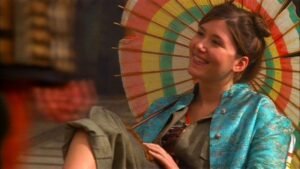The first printed ARCs (Advance Reader Copies) have come in, and I have one to give away.

A photo of the bound advance reader copy of Poisoned Blade, with a cover mostly blue with gold/yellow highlights and a stylized arrowhead-blade across the center. Cover says: Poisoned Blade, A Court of Fives novel, by Kate Elliott
Poisoned Blade is the sequel to Court of Fives.
Here is a brief excerpt:
The setting sun spills gold across the sea. Boats bobbing atop the quiet waters fade into twilight and flicker like spark-bugs as sailors hang lamps from their prows. The main avenues of the city flare lamp by lamp into life as the queen’s royal lamplighters kindle the night-lanterns.
On Rest Day Eve all the theaters run evening performances. It’s the most crowded night of the week, but with the bulk of the king’s army marched east, fewer people than normal pass under the West Gate of the Lantern District. We have plenty of room to walk along the district’s streets hung with colorful banners advertising the plays on offer this month. Just as I had hoped, there is enough time for us to shop along a lane of clothing stalls, where I buy an inexpensive ankle-length linen dress in the sleeveless, straight cut that has always been the fashion in Efea.
“Why do you keep looking back?” Mis asks as we stand at a food stall stuffing ourselves on a Patron delicacy of fresh pancakes wrapped around a paste of chopped almonds, dates, and cinnamon.
Fortunately my mouth is too full of the sweet, hot filling to reply, because I have spotted two men wearing the Garon Palace badge depicting a horned and winged fire dog. Although they don’t seem to be paying attention to us, I am sure they are following. We are easy to spot: Commoner girls wearing long sleeveless jackets that mark us as members of a palace household. We also wear the fire dog badge to indicate our affiliation.
A group of Patron men I’ve never seen before approach, and we four stiffen, wondering if they mean to offer an affront.
The eldest steps forward as the others whisper at his back. He has the muscular arms of a laborer but wears his hair long and bound up atop his head in the style of old Saro. He even speaks Saroese with the accent of old Saro, not the way Patron folk who have grown up here in Efea speak it. “Are you that one called Spider, who won the first trial at the Royal Fives Court in the victory games?”
I swallow. “I am.”
He nods at his companions, and they give me the kiss-off gesture familiar to every person who runs or watches the Fives. Here on the street it can be a mortal insult, or a sign of respect.
“Well run, Adversary,” he says. “You’re one to watch with those spins and flairs. We’ll be cheering for you.”
He pays for all our pancakes, and they go off without asking a thing in return.
+++
In February I am going to be starting an occasional series in which I, or guest bloggers (both writers and readers, and writers as readers) talk about working with tropes in fiction, and also about reading kinks (things you always love when they show up in a book) from a variety of viewpoints. In tribute to this forthcoming discussion:
TO ENTER FOR THE ARC of Poisoned Blade:
Make a comment, below, about a reading kink you love — that is, a trope or type of character or a plot thing or whatever that if it shows up in a book kind of hits all your buttons (in a good way). So for example I might write: “Arrogant dudes who fall in love and have to get humble to get the love interest, a la Mr. Darcy” or “the outsider who is kind of bullied or ignored and who ends up finding she has special powers and a super destiny,” because those are both tried and true (and often cliched) tropes that are reading kinks for me.
Remember: No reading kink is shameful. It just is.
USA & INTERNATIONAL OKAY
Contest open for 8 days (closes Monday February 1st at 10 pm Hawaii Time, which is Tuesday in the rest of the world).
I’m not entering (obviously) but to get things started I’m going to write in a few weeks about one of my favorite tropes (and reading kinks) which I have explored in various ramifications over and over in my fiction, and that is: The Forced Marriage. I have no idea why I love this trope. I just do.
Good luck!







